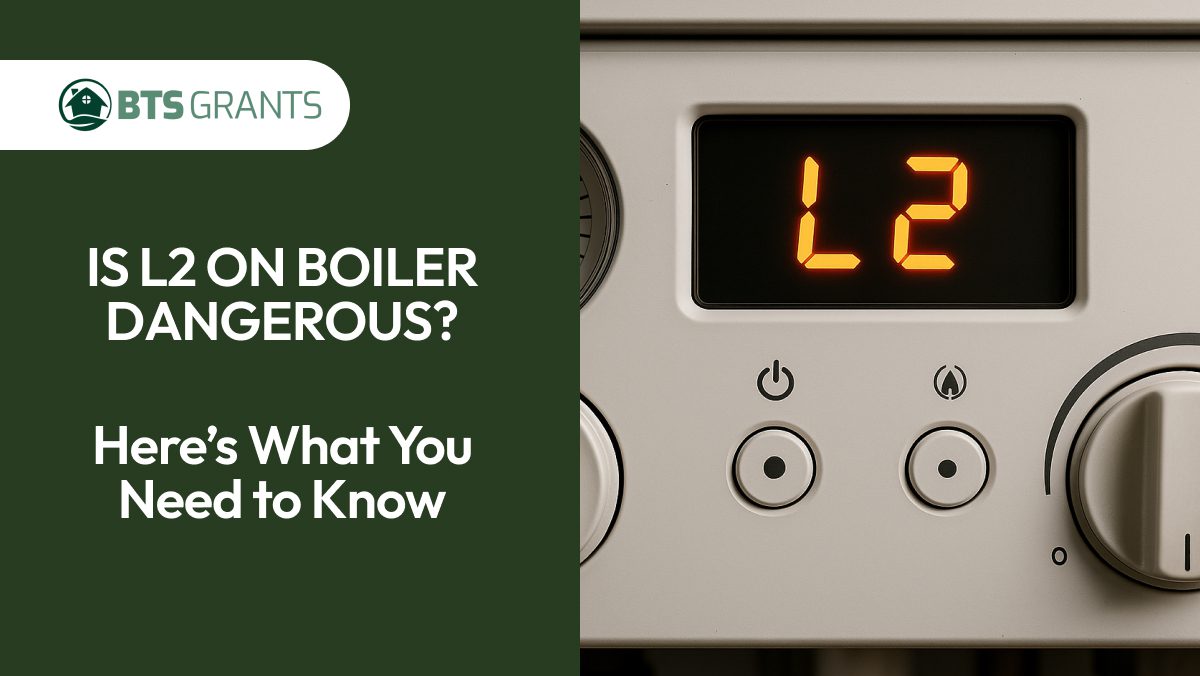When L2 suddenly flashes up on your boiler, it’s easy to worry. The good news is that L2 on a boiler usually isn’t dangerous by itself—it’s a protective lockout that stops your system from trying to run when the flame won’t light or won’t stay lit. In this friendly guide, we’ll explain what L2 means on a boiler, why it happens, what you can safely try at home, and when it’s best to call a professional. You’ll also find simple prevention tips to help you avoid logic boiler L2 when the weather turns cold.
What does L2 mean on a boiler?
In plain English, L2 means your boiler tried to ignite but couldn’t, or it lit and then the flame went out. The appliance then locks out for safety, so it doesn’t keep feeding gas without a stable flame. If you’re wondering about the ideal boiler L2 meaning, it’s precisely that: an ignition fault/lockout. On Ideal’s Logic range, you’ll often hear it described as a flame loss or failed ignition error—the L2 fault code on Ideal Logic boilers is the same core issue.
Key takeaway: L2 = ignition problem + safe shutdown. It needs attention, but it’s not a panic situation.
Is L2 dangerous?
On its own, L2 on a boiler isn’t a danger sign—it’s a safety feature. The lockout prevents the boiler from running in an unsafe condition. However, the reason behind the L2 code (for example, no gas supply, a blocked flue, or a frozen condensate pipe) still needs to be identified and resolved. If you smell gas, hear unusual noises, or the fault keeps returning, turn the boiler off and call a Gas Safe engineer.
Common causes of L2 (and how they lead to a lockout)
Understanding the “why” behind logic boiler L2 helps you fix it faster:
- Frozen or blocked condensate pipe
In cold weather, the plastic pipe that drains condensate outside can freeze. When it blocks, the boiler may struggle to ignite or keep the flame lit, triggering L2. - Gas supply or pressure issues
An empty prepayment meter, a gas valve that is turned off, or low pressure from the supply can all cause a failed ignition. This is a very common, easy-to-miss culprit. - Flame sensor or ignition parts
A dirty or failing flame sensor can’t “see” the flame reliably. Similarly, worn ignition leads or a weak spark can cause intermittent lighting and an L2 fault code. - Gas valve problems
If the valve sticks or isn’t modulating correctly, there may not be enough gas reaching the burner to light or stay lit. - Flue or ventilation faults
Blocked flues, nests, or inadequate airflow may disrupt combustion and result in the flame falling out. - Control board (PCB) faults
Less common, but if the PCB isn’t communicating properly with sensors or the ignition sequence, you can see repeated L2 lockouts.
What you can safely try at home (step-by-step)


If you’re searching for how to fix L2 on a boiler or how to fix L2 on a boiler, start here. These steps are simple, safe, and often effective. If at any point you feel unsure, stop and call a professional.
- Check the fundamentals:
- Power: Make sure the boiler is receiving electrical power and that the fuse hasn’t tripped.
- Gas: If you are on a prepayment meter, make sure you have credit. Ensure any isolation valves are open and that other gas appliances function.
- Power: Make sure the boiler is receiving electrical power and that the fuse hasn’t tripped.
- Try a simple reset:
Most boilers have a reset button. Press and hold it as per your manual (usually a few seconds). If the L2 clears and the boiler runs normally, great. If it returns repeatedly, you have an underlying issue to address. - Smell (and listen) for clues:
- Condensate pipe: Outdoors, check for icing or apparent blockages.
- Flue terminal: Ensure it’s free from rubbish.
- Noises: Clicking without ignition or short-period intermittent flame often points to ignition/flame detection faults.
- Condensate pipe: Outdoors, check for icing or apparent blockages.
- Thaw a frozen condensate pipe (if it’s cold outside):
- Pour warm (not boiling) water over the outdoor section of the pipe.
- Repeat gently until the ice clears.
- Reset the boiler again.
- If this fixes the issue, plan to insulate the pipe to prevent a repeat.
- Pour warm (not boiling) water over the outdoor section of the pipe.
- Recheck the gas supply:
If other gas appliances won’t light, or your meter shows low pressure/credit, sort that first. Restoring regular supply often clears L2.
Stop here for DIY. Anything beyond these basics—like cleaning/replacing flame sensors, testing ignition leads, adjusting gas valves, or opening the boiler case—should be done by a Gas Safe engineer.
When to call a professional
- The L2 fault keeps coming back after you’ve checked the supply and thawed the condensate.
- You suspect an ignition component, flame sensor, gas valve, or PCB issue.
- You notice strange odours (primarily gas), burn marks, or frequent short cycling.
- You’re not confident doing the safe checks above.
A qualified engineer can run combustion checks, verify gas pressures, inspect and clean the burner and sensor, test the ignition system, confirm flue integrity, and update firmware or replace parts if needed.
Preventing L2 in the future
A little prevention goes a long way—especially before winter:
- Annual service: A yearly visit keeps ignition parts clean, checks combustion, and spots wear before it causes L2 on a boiler.
- Insulate the condensate pipe: Employ sound weather-proof insulation and provide a good fall, minimal outdoor run, and a sufficient bore size to withstand freezing.
- Keep vents and flues clear: Don’t clog air intakes; clip plants back from the flue terminal.
- Keep an eye on your gas supply: keep prepaid meters in credit and report pressure problems immediately.
- Act soon: If your boiler requires frequent resets or fails to light, don’t wait until there’s a cold snap—get it checked out.
Common repair routes (what an engineer would do)


Although each property is unique, engineers typically adopt a pragmatic triage for L2 fault code on Ideal Logic boilers.
- Combustion and pressure tests are conducted to ensure safe operation and a sufficient gas supply.
- Check/clean the flame sensor and burner, and test the ignition leads and spark generator.
- Make sure the gas valve is working correctly; calibrate or replace it if necessary.
- Scan the flue for neat, clear exhaust and proper condensate drainage.
- Check PCB for proper sequencing and communication with sensors.
This is a structured procedure, not just clearing the current L2 fault but also reducing its potential for recurrence.
Conclusion
All that said, if the L2 fault persists despite professional intervention, it may indicate that your boiler is nearing the end of its life. Under those circumstances, installing a new, more energy-efficient system may be the more intelligent option. The good news? You may qualify for a free boiler scheme, which ensures your old boiler is replaced at minimal to zero expense, reducing your energy bills.
FAQ’s
Not by itself. L2 is a safety lockout that prevents the boiler from operating when there’s an ignition problem. Treat it as necessary, not alarming—perform the necessary checks and call a professional if the issue persists.
It indicates an ignition failure or flame loss. The boiler either couldn’t or wouldn’t light and then go out, so it shut down to remain safe.
On the Logic range, L2 is the same core issue: ignition failure/flame loss. You’ll often see it in cold weather (frozen condensate), but gas supply, ignition parts, gas valves, or flue/airflow problems can also cause it.
Typical causes are a plugged/blocked condensate pipe, low or disrupted gas supply, defective flame sensor/ignition unit, gas valve malfunction, or flue/ventilation blockage.
You can try a reset, check the gas supply/credit, and thaw an iced condensate pipe with warm water. Anything involving internal components should be left to a Gas Safe engineer.





